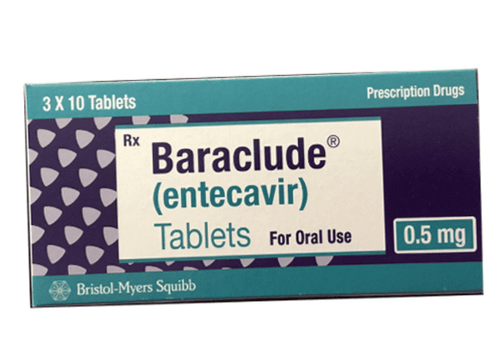This is an automatically translated article.
Agicarvir's main ingredient is Entecavir, a medicine to treat chronic hepatitis B. Knowing the basic information of Agicarvir and using it according to the instructions of the doctor will help patients treat it safely and effectively.
1. What is Agicarvir?
Agicarvir is made in the form of film-coated tablets and packed in boxes of 3 blisters x 10 tablets. The main ingredients of the drug include:
Active ingredients: Entecavir monohydrate 500mg; Excipients 1 capsule. Entecavir is a prodrug, a guanosine derivative. When absorbed into the body, Entecavir is phosphorylated to the active form, triphosphate, which has the ability to compete with the substrate deoxyguanosine triphosphate. Viral B virus is inactivated because entecavir triphosphate inhibits HBV DNA polymerase.
2. Indications and contraindications of Agicarvir
Indications for Agicarvir
Use Agicarvir to treat the following cases:
Chronic hepatitis B in adults with clear evidence of viral replication or persistent elevation of liver enzymes. Hepatitis B virus is expressed on liver cells. Contraindications to the use of Agicarvir:
People who are allergic, hypersensitivity to Entecavir or components of Agicarvir.
3. Usage and dosage of Agicarvir
Usage:
Agicarvir is used orally. The patient took the entire tablet of Agicarvir 0.5g. Do not chew, break, or crush as this will reduce the absorption of the drug. The drug should be taken on an empty stomach, usually 2 hours after a meal or 2 hours before the next meal. The drug is recommended for use by adults or children over 16 years of age.
Dosage
Chronic hepatitis B without nucleoside: 0.5 mg/time/day. Decompensated hepatitis: 1mg/day. Persons with a history of hepatitis B virus infection while taking Lamivudine or lamivudine resistance mutations: 1mg/time/day. For patients with renal insufficiency, the dose should be adjusted according to Creatinine clearance (CrCl):
CrCl from 30 to 50 ml/min: 0.5 mg every 48 hours. If Lamivudine resistance is present: 0.5mg/time/day. CrCl from 10 - 30 ml/min: 0.5mg every 72 hours, equivalent to 1 tablet. If lamivudine resistance is present, a dose of 0.5 mg every 48 hours is recommended. CrCl < 10 ml/min, on hemodialysis or peritoneal dialysis: 0.5 mg every 5-7 days. If lamivudine resistance is present, a dose of 0.5 mg is given every 72 hours. If the dose is less than 0.5 mg/day, the oral solution should be used.
People with impaired liver function: No need to adjust the dose.
4. Notes when using Agicarvir
Side effects of the drug Agicarvir
Entecavir can lead to lactic acidosis, which starts slowly but gets worse over time with symptoms such as:
Cold, numbness of hands and feet; Muscle weakness, muscle pain; Fatigue, fainting, dizziness; Shortness of breath; Cardiac arrhythmia: Slow or irregular. Liver symptoms:
Mild or moderate fever; Dark urine, pale stools; Loss of appetite, nausea, stomach pain; Yellow eyes, yellow skin. Other minor symptoms:
Headache, insomnia; Redness of the skin; Hair loss; Nausea, indigestion, diarrhea. Some notes when using Agicarvir:
Caution in people with impaired renal function. CrCl should be tested before dosing is prescribed to the patient. For patients with creatinine clearance less than 50 ml/min, dosage adjustment is required. Patients should be informed that hepatitis may worsen after discontinuation of treatment. Therefore, liver function must be monitored after discontinuation of the drug, both clinically and on laboratory tests. Entecavir has not been studied in patients co-infected with HIV and HBV. However, there are no recommendations for the use of Entecavir in HIV/HBV coinfected patients. Lactic acidemia and hepatomegaly with steatosis may occur with the use of nucleoside analogs alone or with antiviral agents Treatment with Agicarvir has not been shown to reduce the likelihood of HBV transmission to others through contact. sex or blood sugar. Pregnancy: There are no adequate studies on the effects of Entecavir on fetal development. Therefore, only use the drug exactly as prescribed by your doctor and after weighing the benefits and risks. Lactation: Entecavir has not been determined to be excreted in human milk. Therefore, mothers using Agicarvir should not breastfeed. Be careful when driving or operating machinery because the drug can cause fatigue, dizziness, drowsiness during treatment with Agicarvir.
5. Agicarvir drug interactions
Agicarvir may interact with nephrotoxic drugs such as Streptomycin, Amphotericin B, Cephalexin, ... or drugs that compete with Agicarvir in the renal tubules. Concomitant use may increase the concentration of Entecavir in the blood or of the co-administered drug.
Above is the basic information about Agicarvir such as ingredients, usage and important notes. Agicarvir is a prescription drug, patients only use the drug when prescribed by a doctor and need to carefully read the instructions for use, follow the correct dose to achieve the best treatment results.













